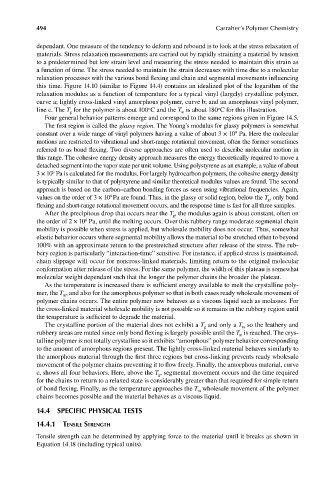Page 531 - Carrahers_Polymer_Chemistry,_Eighth_Edition
P. 531
494 Carraher’s Polymer Chemistry
dependant. One measure of the tendency to deform and rebound is to look at the stress relaxation of
materials. Stress relaxation measurements are carried out by rapidly straining a material by tension
to a predetermined but low strain level and measuring the stress needed to maintain this strain as
a function of time. The stress needed to maintain the strain decreases with time due to a molecular
relaxation processes with the various bond flexing and chain and segmental movements infl uencing
this time. Figure 14.10 (similar to Figure 14.4) contains an idealized plot of the logarithm of the
relaxation modulus as a function of temperature for a typical vinyl (largely) crystalline polymer,
curve a; lightly cross-linked vinyl amorphous polymer, curve b; and an amorphous vinyl polymer,
o
o
line c. The T for the polymer is about 100 C and the T is about 180 C for this illustration.
g m
Four general behavior patterns emerge and correspond to the same regions given in Figure 14.5.
The first region is called the glassy region. The Young’s modulus for glassy polymers is somewhat
9
constant over a wide range of vinyl polymers having a value of about 3 × 10 Pa. Here the molecular
motions are restricted to vibrational and short-range rotational movement, often the former sometimes
referred to as bond flexing. Two diverse approaches are often used to describe molecular motion in
this range. The cohesive energy density approach measures the energy theoretically required to move a
detached segment into the vapor state per unit volume. Using polystyrene as an example, a value of about
9
3 × 10 Pa is calculated for the modulus. For largely hydrocarbon polymers, the cohesive energy density
is typically similar to that of polystyrene and similar theoretical modulus values are found. The second
approach is based on the carbon–carbon bonding forces as seen using vibrational frequencies. Again,
9
values on the order of 3 × 10 Pa are found. Thus, in the glassy or solid region, below the T , only bond
g
flexing and short-range rotational movement occurs, and the response time is fast for all three samples.
After the precipitous drop that occurs near the T , the modulus again is about constant, often on
g
6
the order of 2 × 10 Pa, until the melting occurs. Over this rubbery range moderate segmental chain
mobility is possible when stress is applied, but wholesale mobility does not occur. Thus, somewhat
elastic behavior occurs where segmental mobility allows the material to be stretched often to beyond
100% with an approximate return to the prestretched structure after release of the stress. The rub-
bery region is particularly “interaction-time” sensitive. For instance, if applied stress is maintained,
chain slippage will occur for noncross-linked materials, limiting return to the original molecular
conformation after release of the stress. For the same polymer, the width of this plateau is somewhat
molecular weight dependant such that the longer the polymer chains the broader the plateau.
As the temperature is increased there is sufficient energy available to melt the crystalline poly-
mer, the T , and also for the amorphous polymer so that in both cases ready wholesale movement of
m
polymer chains occurs. The entire polymer now behaves as a viscous liquid such as molasses. For
the cross-linked material wholesale mobility is not possible so it remains in the rubbery region until
the temperature is sufficient to degrade the material.
The crystalline portion of the material does not exhibit a T and only a T so the leathery and
g m
rubbery areas are muted since only bond flexing is largely possible until the T is reached. The crys-
m
talline polymer is not totally crystalline so it exhibits “amorphous” polymer behavior corresponding
to the amount of amorphous regions present. The lightly cross-linked material behaves similarly to
the amorphous material through the fi rst three regions but cross-linking prevents ready wholesale
movement of the polymer chains preventing it to flow freely. Finally, the amorphous material, curve
c, shows all four behaviors. Here, above the T , segmental movement occurs and the time required
g
for the chains to return to a relaxed state is considerably greater than that required for simple return
of bond flexing. Finally, as the temperature approaches the T wholesale movement of the polymer
m
chains becomes possible and the material behaves as a viscous liquid.
14.4 SPECIFIC PHYSICAL TESTS
14.4.1 TENSILE STRENGTH
Tensile strength can be determined by applying force to the material until it breaks as shown in
Equation 14.18 (including typical units).
9/14/2010 3:42:38 PM
K10478.indb 494 9/14/2010 3:42:38 PM
K10478.indb 494

